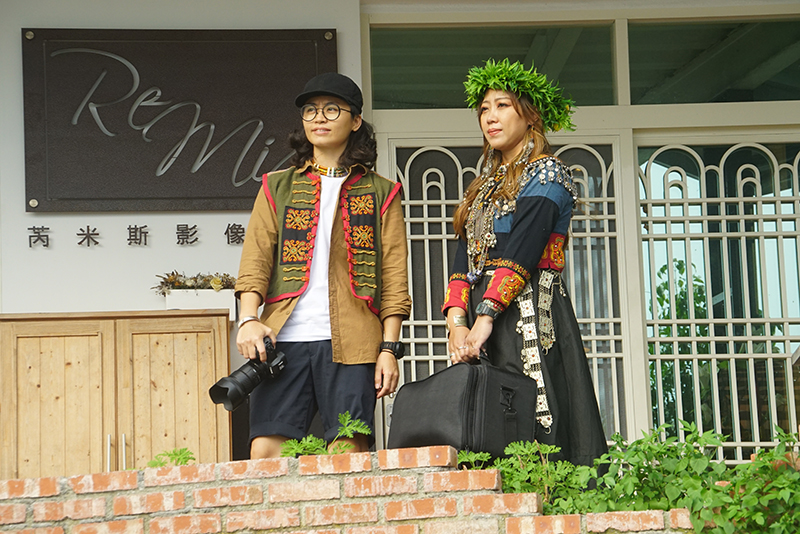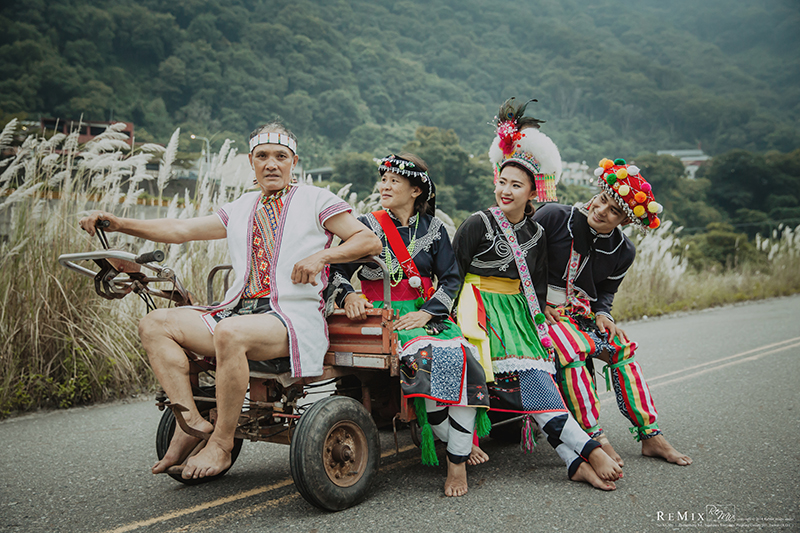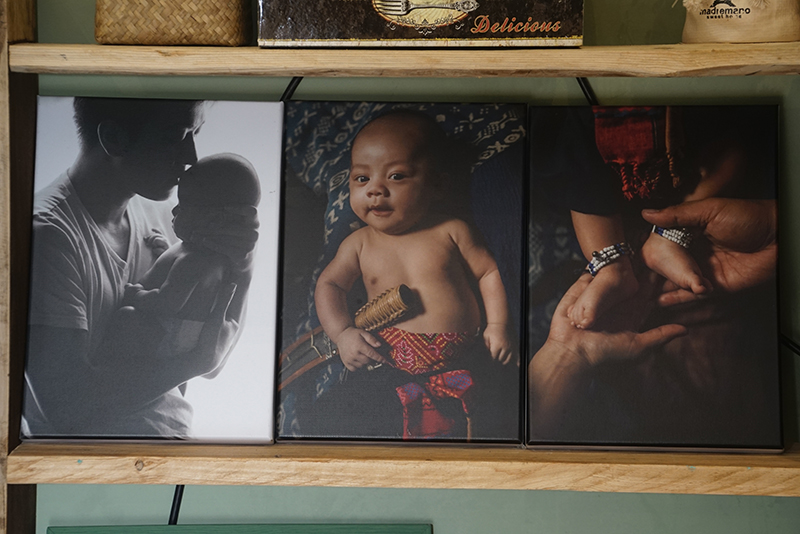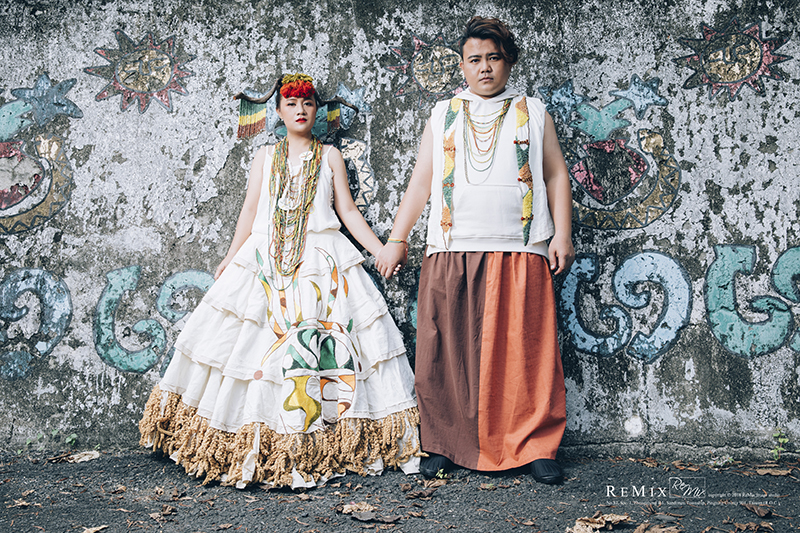This is not the fairy-tale and dreamy type of pre-wedding portraits popular among the contemporaries. White gowns, balloons, bouquets and romantic setting are no where to be seen. In these pictures, the brideand-groom-to-be wears feathers and flower adorned headdresses and are clad in glamorous indigenous costumes with glazed beads and embroidery outlining intricate patterns. Behind them are magnificent mountains, slate stone houses, old indigenous villages devastated by typhoon, woods, waterfall, crag or cliffs. The newlyweds-to-be pose on their ancestral homeland with chins slightly raised and thoughtful and focused gaze on their faces. They appear to be confident, proud and gorgeous.
“When the newlyweds to-be put traditional indigenous costumes, you see immediate change in the looks in their eyes. That unrivaled confident and bright looks on their faces are something you cannot find when they are in western style gowns/ suits.” Said Jimmy earnestly, as she looked at the indigenous pre-wedding portraits ReMix took in the past four years.

Paiwan girl Res and Minnan girl Jimmy work together on pre-wedding portrait shooting. They share the same ideal and aspiration: by taking pre-wedding portrait photos they can document indigenous cultures and the natural surroundings.
The Encounter
between a Paiwan Girl and a Minnan Gir
Res Matilin comes from Sandi Village, a Paiwan community in Pingtung County. Jimmy comes from Alien Township, Kaohsiung City and has Minnan ethnicity. “I decided to come back because I really missed home. I had been away from home for too long.” When it comes to the reason of moving back home, Res said that she grew up in her indigenous community but had to move to the city in order to go to school when she was in junior high. She made up her mind to move back home when a family member fell ill. When she first moved back, Res was taking care of her family member, she also made sure that she acquire skills, making the most of her youth. Therefore, she became an assistant to a make-up artist to pick up the trade.
Jimmy was a fervent photographer who was into story and landscape photography when she was in school. Originally her plan was to take over family business after graduating from university, but she changed her mind and joined pre-wedding photography business after her friend got her into this trade. Both of them started their careers as assistants. Committed in their own careers, they have developed solid professional skills. They met on one joint assignment and started to collaborate regularly as they are like-minded.
“Because I live in an indigenous community, most of my cases came from my people. The newlyweds to be who seek out independent studios for prewedding portraits mostly already have idea in mind. And they want tailor-made services.” Rex found that young indigenous couples already have different ideas about pre-wedding portraits. With a strong sense of indigenous identity, they want their portraits to be taken in their own communities with traditional costumes. Costumes, apparels and locations for photo shoot have to be tailored to specific needs. In addition to that, theses assignments also challenge the photographer's sensitivity to cultural nuances.
Res found Jimmy is a good listener to the needs of newlyweds-to-be and she respects indigenous culture while they worked on assignments together. “The person behind the camera has to have a good understanding of and exposure to our culture so that he/ she can produce works with heartwarming touch.”
Jimmy explained frankly that she first worked for big pre-wedding portraits studios. With prepackaged services, indigenous style portraits usually only involved different costumes. It was merely about looking good in the picture rather than being attentive about cultural details, not to mention the taboos about costumes, artifacts used on set and expressing cultural understanding. Therefore, lots of her behaviors showed ignorance.
The longer she worked a photographer, the better she masters the skill. Jimmy joked about being able to take photos with her eyes shut. However, she also became ever more confused. “Does pre-wedding portraits have to be this rigid?”
She found new possibilities for pre-wedding portraits when she worked on indigenous assignments with Res.” The western style portraits are mainly about looking good and beautiful. In contrast, one sees the unrivaled strength and vitality in traditional indigenous costumes, old villages and the newlyweds own cultural identity. “She followed the indigenous newlyweds-tobe into mountains and to seaside to take photos. Jimmy learned stories of people from different groups. These experiences rekindled her passion in photography.

A Pre-wedding Portrait Studio in an Indigenous Community
Go Home with the Newlyweds to Take Photos
As Jimmy's fondness of indigenous culture deepens, she wanted to further pursue this in her work. “I want to ‘move bake’ to the community so that I can better understand your culture.” Jimmy proposed the idea to Res.
“If I am to move back, then it should be where I grew up so that my life could really take root there.” Res said. They started the preparation for the ReMix Studio at the end of 2016. Taking “Re” from Res and “Mi” from Jimmy's nickname, the title ReMix also indicates the fusion of Paiwan and Minnan identities which leads to unique creativity. They went back to indigenous homeland to rediscover the pure beauty of their culture. With their hard work and funding from the Council of Indigenous Peoples, they rented a warehouse in Sandi Village in 2017 and ReMix formally opened.
ReMix has shot indigenous pre-wedding portraits with many different themes and stories after the opening of the studio. They brought on all kinds of challenging shooting sites according to the wish of these couples, including Tjuvecekadan stone slate village, Payuan village, North Dawu Mountain, Orchid island. “Through word of mouth advertising, prewedding portraits in places like indigenous communities, mountains and seaside have become the signature style of ReMix branding.” Jimmy said with a smile.
“We encourage couples to take their pre-wedding photo shoot home.” Res said. Unlike other studios which would reject remote sites for photo shoot or raise their quote, there are no places remote or inaccessible enough to stop ReMix from going. Their jeep goes anywhere as required and they only charge transportation cost with no additional fee attached. It is not that cost is not a concern for them but both Res and Jimmy see that “Going home is what motivated us to set up ReMix in the first place. If we make taking pre-wedding photo shoot back home difficult for couples, then we might as well not to move back.”



ReMix not only takes pre-wedding portraits but also pictures of family and newborn babies. The studio capture every critical moments of clients’ lives.
More than Just Pre-wedding Photo Shoot
Attentive to Cultural Nuances and Taboos
Before they go to an indigenous community for photo shoot, ReMix would repeatedly confirm with the newlyweds about the rituals they have to be careful about. They would prepare millet wine and betel nuts as offerings to ancestral spirits and mountain gods. If the newlyweds are not certain about these rituals, ReMix would ask them to check with elders in the family to make sure no taboos are broken. It's never too much to verify the correct way to put on the traditional costumes and apparels over and over again. “When we are on set, I would stop and ask the newlyweds to adjust their costumes even it's a tiny thing that is out of place.” Jimmy said.
For indigenous people, different apparels represent different social status. Getting the costume wrong is a big deal. Res and Jimmy are extra careful about these cultural details to avoid accidentally breaking cultural taboos.
“As an indigenous person, photo shoot for me is not just a job. We want to convey cultural messages correctly as well.” Said Res. They want to strike a balance between business operation and cultural awareness. They spend lots of time learning clients' needs and stories before they propose the best approach to portraits that they genuinely feel right.


Documenting the Disappearing Landscape
and Visages of Elders in Indigenous Communities
“We found the landscape of our homeland as we know it since childhood disappearing. That is why we promote the idea of taking pre-wedding photo shoot back home. “Res felt this deeply. With the invasion of modern civilization, the landscape of their community is slowly transforming. And they should capture these scenes now before they are gone. Therefore, they also encourage couples to ask their families to be in the photos as well. According to Jimmy, the elders are the keepers of the precious indigenous cultural heritage. With their passing, the culture may be gone too. “We seize the opportunity to capture pictures of the elders in their formal costumes when we take these pre-wedding portraits.”
“It is our humble wish to cover pre-wedding photos for all the 16 indigenous peoples of Taiwan so that we can preserve cultures of different groups with camera. Then we are going to organize an exhibition on a minivan and take it on a tour to every indigenous community.” For Res and Jimmy, ReMix is more than a pre-wedding portrait studio. For them, it is a cause and dream that take root on indigenous homeland.

The couple, clad in traditional indigenous costumes, stand before the colorful urban building, conveying a sense of beauty which is conflicting and harmonious at the same time.




